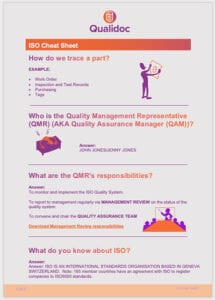“I am so clever that sometimes I don’t understand a single word of what I am saying.”
― Oscar Wilde, The Happy Prince and Other Stories
I hope I never give that impression with my writing. I sometimes edit my writing to the extent that I come full circle, back to where I started (well, almost).
Unfortunately, in quality system development, Documentation Control still takes far too big a toll on certification assessments and can create chaos if not given sufficient attention. One of my first tasks in any contract is to review the documentation, get rid of anything that is redundant and make sure all the rest is fit for purpose.
It is one thing to identify which documents are needed (and well done if you have managed that) and another to make sure they contain the correct information in terms that are familiar to the reader, and clear if the reader is unfamiliar with the process.
Many years ago I was given a contract by a national railway company to work with retired engineers who were rewriting maintenance procedures for locomotives. Their idea of a procedure was to extract lumps of information from General Motors and other Original Equipment Manufacturers (OEMs) hefty instruction manuals, and plonk them onto sheets of paper ad hoc.
Many painful months later I had managed to persuade them to set out a logical sequence of events with the readers’ needs in mind; e.g., if oil on a hot engine was a safety hazard, then Page 8 was not the place to state it. Warnings, (especially safety) had to be on Page 1, Para 1.
The reader’s needs are paramount. If the reader loses interest or focus you have wasted your time, particularly when you are trying to persuade employees of long experience and standing in the company that changes are needed. You can’t make a big splash when the tide is out. Before distributing the documentation even in the first draft. ask yourself:
- Is the information in the logical sequence which is most beneficial to the reader who is following the instruction?
- What is the preceding connection which the reader may need to know so that he or she can pick up the threads?
- Can the reader discover quickly where he/she is, by page and part?
- Is high order language used to ensure the appropriate level of formality without slipping into obscurity?
Many people are mad about flow charts and are convinced that they are the answer to all information processing needs. Flow charts are excellent when they portray step by step processes which require no assumptions to be made on the part of the reader. Too often I have found the categories have been named without sufficient accuracy, and so the reader is left floundering and making assumptions, which can be awkward, if not disastrous. Flow chart categories must be specific and connections must be watertight. They should also show responsible authorities within each step; that is, Operating Superintendent, not John Brown. John Brown’s name will show on the Signatories List which is part of the Master Document List.
More critical questions to be asked before developing documentation are:
Who is the reader?
What does he or she need to know?
When do they need to know?
Who approves the first and subsequent drafts and authorises publication?
Who is in charge of the Master Document List? (Usually the Quality Management Representative or delegated authority, shown on the Corporate Organisation Chart)
Who needs access on a Read Only basis?
Are all interested parties identified who might need copies and are the copies controlled or uncontrolled?
It pays to submerge our egos when undertaking this very important task. We can’t afford to imitate Oscar Wilde; too much is at stake.
THE QUALIDOC QUALITY SYSTEM PACKAGE CONTAINS ALL THE DOCUMENTS NEEDED FOR A COMPREHENSIVE QUALITY SYSTEM. MANY DOCUMENTS ARE PROVIDED WITH LINKS TO THE PROCEDURE. OTHERS ARE INDICATED WITH THEIR PLACE IN THE PROCESS.
